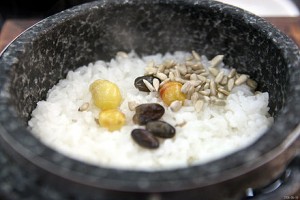For this week I decided to order food from a Korean restaurant, Maki Yaki off Order Up. I got veggie sushi and egg rolls which was all good. The sushi was pretty large to eat in one bite and the food took over an hour to come so that was a little disappointing. However, the price and quality of the food made up for it.
Korean food has evolved greatly over time due to cultural, social, political and environmental changes. Similar to other asian cuisines, Korean cuisine is comprised of mostly rice, vegetables and a variety of meat. One of the most common things Koreans do is serve side dishes (banchans) to consist of steam cooked short grain rice. A popular side dish is kimichi which is made of vegetables and a variety of seasonings; it is often either described as sour or spicy. Other popularly used ingredients include sesame oil, doenjang (fermented bean paste), salt, garlic, ginger, soy sauce, pepper flakes, and gochujuang (fermented red chili paste).
One of the most important foods in the Korean diet is grains, and there are even myths of how they acquired grain (that’s how important it is). When rice was first introduced to Korea it was extremely expensive, therefore the people mixed it with other grains to “stretch the rice”. This is still used today in some dishes. Other dishes consist of rice cooked in a sot, the same method used for centuries.
There are different important aspects of a Korean meal. Soup is served with the meal as opposed to traditionally done here before the meal. Guk is a type of soup often made with meats, shellfish, and vegetables. More formal soups that are served as the meal are usually referred to as tangs, and stews are known as jligae. There is also a big emphasis placed upon side dishes.
Korean food has a very intensive etiquette that can be traced by to Confucius’s time. Many of the earlier rules (such as the men and women ate separate, eldest male ate first, to never eat so fast to look as though you’re taking someone else’s food or eat to slowly to seem as though you aren’t enjoying it) have been relaxed but there are still some etiquette rules in place. For example, the younger people of the table should not start eating until the elders have nor should they finish before them. Contrary to other Asian cultures, the rice bowl is not lifted from the table when eaten. This is due to the fact that along with chopsticks, people are given a spoon (called a sujeo) that is expected to be used for soup and rice. The setup of the table is also significant with hot foods set to the right of the table and cold foods to the left. When drinking alcohol, diners are supposed to face away from the eldest male and cover their mouth.
Fun Facts:
The fourth most consumed meat in Korea is dog meat
Korea is the largest consumer of garlic




I’ve never tried Korean food before, but it looks quite good! Your fun fact at the ends make me consider the cultural variety that is expressed through cuisine. If the same thing was done here in the U.S. you’d have newspapers and reporters all over it, bringing forth the wrath of animal rights’ movements and just your average puppy dog lover.